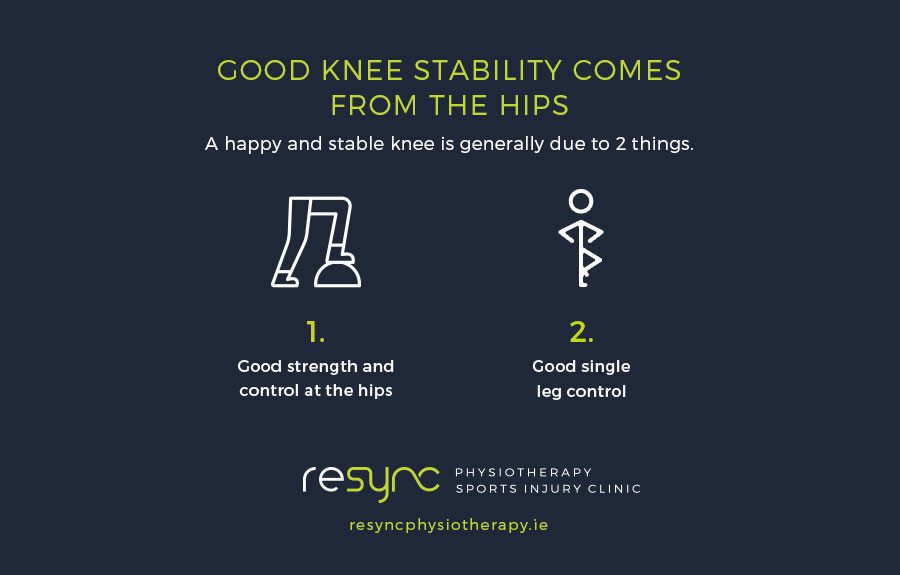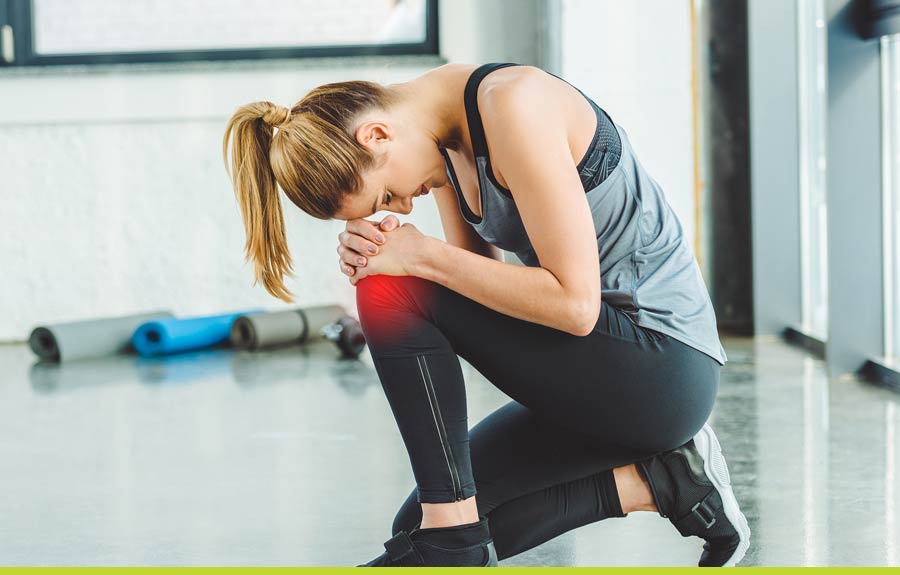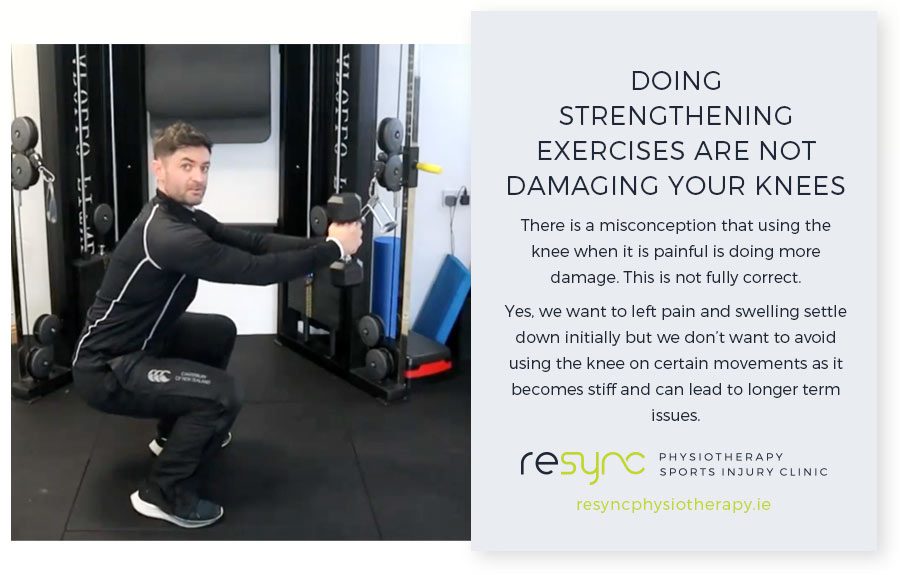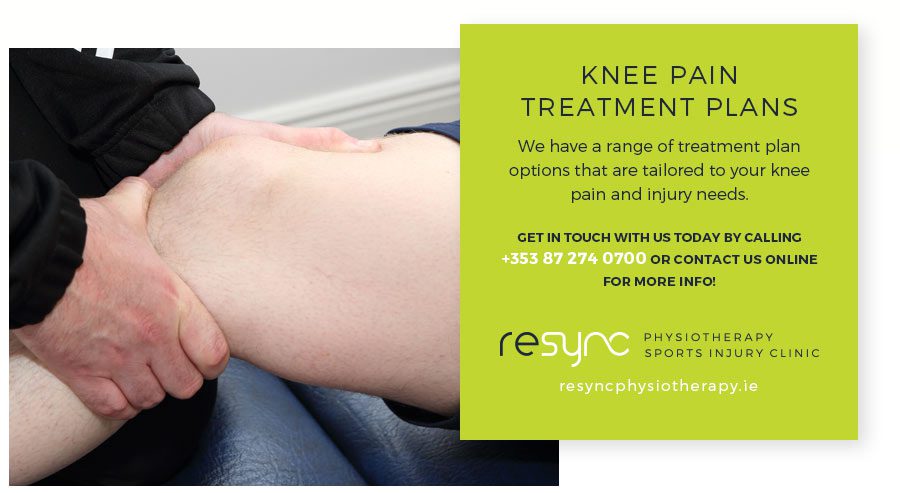Knee pain affects many of us in our lifetime, whether old or young it can stop us in our tracks and affect our activity levels. A lot of information you have gathered in search for a solution to your pain may not be fully accurate, so we have shared some considerations below that you may not have been aware of. The points below are the 7 things you probably didn’t know about knee pain, read on and see if some of them can help make a difference.
Table of Contents
1. You Need to Train Your Hamstrings More Than Your Quads
2. Good Knee Stability Comes From The Hips
3. Poor Training Plan May Be Affecting Your Knee Pain
4. Check Your Knee Alignment for Knee Pain
5. Strengthening Exercises Are Not Damaging Your Knees
6. Most People Have Some Wear & Tear in Their Knees
7. Your Return to Exercise Plan for Knee Pain Should Include Jumping & Landing
Knee Pain Summary
1. You Need to Train Your Hamstrings More Than Your Quads
Many people that we see in the clinic with knee pain tend to train the front of the thigh (quadriceps) a lot more than the back of the legs (calves, hamstrings, and glutes). A big reason for this is that many people have turned to home workouts and have little access to equipment and weights they may have used pre-lockdown in the gym. Exercises like bodyweight squats and burpee jumps overload the quadriceps making them develop tightness over time when we do not have adequate strength through the hamstrings and glutes.
Another reason is when we run at a slower speed like jogging the quadriceps are the dominant force producer to propel us forward to the next step possibly leading to overload of the front of the knee as that is where the quadriceps attachment site is. Therefore, it is important that we share the loading forces around the knee.
We do this by focusing on strengthening the hamstrings as well as the calves and glutes. The hamstrings play an important role in transferring the load from the lower leg to the hips to propel us forward especially at faster speeds.
2. Good Knee Stability Comes From The Hips
A happy and stable knee is generally due to 2 things:
- Good strength and control at the hips
- And good single leg control

Most of the time when we see poor single leg control on jumping, hopping and landing assessments it is generally down to a lack of ability to control the hip joint. The muscles around the hips act to stabilise us when we have to load through 1 leg such as walking, jogging, or playing sports.
When we are walking or jogging, and we suddenly meet a bump in the ground, the knee may move inwards towards the other knee. Here there is a risk to the knee getting injured as we cannot control at the hip to prevent the movement.
You may have had a traumatic injury involving this movement previously or it could be happening every time you are landing while exercising and jogging. This overloads the knee in a sub-optimal position as the knee tends to just like forwards and back movements (Flexion & Extension). With the majority of people we see in clinic we tend to focus on what is happening at the hip and if the person has good single leg control to protect the knee.
3. Poor Training Plan May Be Affecting Your Knee Pain
If there are any previous injuries to the joint or the leg muscles, then these deficiencies can show up when there is a sudden increase in your training load. What this means is that if you have started a new running or gym plan for example then this new weekly load on the muscles or joint may flare up old injuries if this new load is sudden and not gradual.
Old injuries that are not rehabilitated fully can lead to compensatory patterns and injury. We tend to get away with this for a long time but when our training load increases, or the body cannot tolerate the new training stimulus due to weaknesses then old issues hold us back.
An old ankle sprain on the left leg may have healed OK after several weeks but the body is not fully loading the left side as an avoidance mechanism. This leads to the brain biasing the right side to take most of the load when exercising. The right knee then gets painful due to it taking up all the load as the muscles around the knee are not providing sufficient force and control.
4. Check Your Knee Alignment for Knee Pain
Did you know you can check your knee alignment and single leg control with this simple movement.
-
- Set yourself up with a chair that is around knee height just behind you.
- Stand in front of a mirror so you can assess the movement yourself.
- Stand on 1 leg.
- Keeping the opposite leg off the ground try to sit back and touch your bum off the chair behind in a controlled manner.
- Try to push yourself back up to the standing position using that same leg (do not use the other leg to help)
- This is basically a single leg squat movement.
- Watch your knee in the mirror. Does The knee cave in towards the opposite knee?
- Here is how: [embedyt] https://www.youtube.com/watch?v=TQ13dLd6FMk[/embedyt]
5. Strengthening Exercises Are Not Damaging Your Knees
There is a misconception that using the knee when it is painful is doing more damage. This is not fully correct. Yes, we want to left pain and swelling settle down initially but we don’t want to avoid using the knee on certain movements as it becomes stiff and can lead to longer term issues We want to slowly get the muscles around the knee activated at the right time and right position after pain or injury so they can share the load and not have the knee joint itself doing all the work.
A simple bridge exercise can get the hamstrings to work again.
A simple chair squat can get the quadriceps to strengthen.
If you need any help or guidance with your knee pain don’t hesitate to contact us here in the clinic.
6. Most People Have Some Wear & Tear in Their Knees
Many people will be worried that grinding or clicking in the knee is a sign of long-term damage. We know from research that knees that show some damage on MRI do not correlate with the levels of pain that patients experience. In other words, many patients will have little or no knee discomfort even though an MRI showed some wear and tear around the joint.
While others may have a perfect MRI but are experiencing pain in the knee. This means that your functional ability is a key factor in getting the knee better after pain or injury.
Therefore, the focus should be on treating the knee to let pain levels settle and then get the muscles around the knee doing their job really well.
7. Your Return to Exercise Plan for Knee Pain Should Include Jumping & Landing
A missing step in knee rehabilitation is that many people return to exercise too soon once their knee pain settles down. This is a mistake as they haven’t gone through a full rehab plan to earn the right to hop and land on that leg again to absorb the forces during running. Running or jogging is essentially hopping from one leg to another over a given distance.
Knee Pain Summary
- Ensure you are strengthening all muscle groups and not only the quadriceps
- Don’t just think about the knee – the hips play a key role in knee health.
- Is your training plan over or under-loading the knee – find the sweet spot.
- MRI’s don’t give a full picture of your prognosis.
- A full rehab and treatment plan is essential to get fully back to exercising pain free.
Knee Pain Treatment Plans
We have a range of treatment plan options that are tailored to your knee pain and injury needs. Get in touch with us today by calling +35316855181 or contact us online for more info!
Check out our Facebook group where we give free advice and tips on a range of issues. And, if you found this post useful make sure you check out our post on 5 common running injuries.





